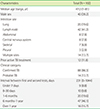1. Zumla A, George A, Sharma V, Herbert RH, Baroness Masham, Oxley A, et al. The WHO 2014 global tuberculosis report--further to go. Lancet Glob Health. 2015; 3:e10–e12.

3. Pai M, Behr MA, Dowdy D, Dheda K, Divangahi M, Boehme CC, et al. Tuberculosis. Nat Rev Dis Primers. 2016; 2:16076.

4. Mazurek GH, Jereb J, Vernon A, LoBue P, Goldberg S, Castro K, et al. Updated guidelines for using interferon gamma release assays to detect Mycobacterium tuberculosis infection-United States, 2010. MMWR Recomm Rep. 2010; 59:1–25.
6. Nemes E, Rozot V, Geldenhuys H, Bilek N, Mabwe S, Abrahams D, et al. Optimization and interpretation of serial QuantiFERON testing to measure acquisition of
Mycobacterium tuberculosis infection. Am J Respir Crit Care Med. 2017; 196:638–648.



7. Winje BA, White R, Syre H, Skutlaberg DH, Oftung F, Mengshoel AT, et al. Stratification by interferon-γ release assay level predicts risk of incident TB. Thorax. 2018; 73:652–661.

8. Woo KS, Choi JL, Kim BR, Kim JE, Kim BG, Lee H. Significance of interferon-gamma response to mitogen in serial QuantiFERON-TB Gold In-Tube assay of routine laboratory practice. Clin Chim Acta. 2014; 430:79–83.


9. Huang HC, Su WJ, Chiang CL, Feng JY, Huang HY, Lin CH, et al. The predictive value of the interferon-γ release assay for chemotherapy responses in patients with advanced non-small-cell lung cancer. Lung Cancer. 2018; 115:64–70.


12. Marais S, Thwaites G, Schoeman JF, Török ME, Misra UK, Prasad K, et al. Tuberculous meningitis: a uniform case definition for use in clinical research. Lancet Infect Dis. 2010; 10:803–812.


15. Fan L, Chen Z, Hao XH, Hu ZY, Xiao HP. Interferon-gamma release assays for the diagnosis of extrapulmonary tuberculosis: a systematic review and meta-analysis. FEMS Immunol Med Microbiol. 2012; 65:456–466.

16. Di L, Li Y. The risk factor of false-negative and false-positive for T-SPOT.TB in active tuberculosis. J Clin Lab Anal. 2018; 32:e22273.

17. Cho OH, Park KH, Kim SM, Park SJ, Moon SM, Chong YP, et al. TB for extrapulmonary tuberculosis according to the site of infection. J Infect. 2011; 63:362–369.

20. Blankley S, Graham CM, Turner J, Berry MP, Bloom CI, Xu Z, et al. The transcriptional signature of active tuberculosis reflects symptom status in extra-pulmonary and pulmonary tuberculosis. PLoS One. 2016; 11:e0162220.

23. Joshi M, Monson TP, Joshi A, Woods GL. IFN-γ release assay conversions and reversions. Challenges with serial testing in U.S. health care workers. Ann Am Thorac Soc. 2014; 11:296–302.


24. Clifford V, He Y, Zufferey C, Connell T, Curtis N. Interferon gamma release assays for monitoring the response to treatment for tuberculosis: A systematic review. Tuberculosis (Edinb). 2015; 95:639–650.


25. Kumar NP, Sridhar R, Banurekha VV, Nair D, Jawahar MS, Nutman TB, et al. Expansion of pathogen-specific mono-and multifunctional Th1 and Th17 cells in multi-focal tuberculous lymphadenitis. PLoS One. 2013; 8:e57123.
26. de Visser V, Sotgiu G, Lange C, Aabye MG, Bakker M, Bartalesi F, et al. False-negative interferon-γ release assay results in active tuberculosis: a TBNET study. Eur Respir J. 2015; 45:279–283.


27. Kwon YS, Kim YH, Jeon K, Jeong BH, Ryu YJ, Choi JC, et al. Factors that predict negative results of QuantiFERON-TB Gold In-Tube test in patients with culture-confirmed tuberculosis: A multicenter retrospective cohort study. PLoS One. 2015; 10:e0129792.

29. Sester M, Sotgiu G, Lange C, Giehl C, Girardi E, Migliori GB, et al. Interferon-γ release assays for the diagnosis of active tuberculosis: a systematic review and meta-analysis. Eur Respir J. 2011; 37:100–111.


32. Zellweger JP, Sotgiu G, Block M, Dore S, Altet N, Blunschi R, et al. Risk assessment of tuberculosis in contacts by IFN-γ release assays. A Tuberculosis Network European Trials group study. Am J Respir Crit Care Med. 2015; 191:1176–1184.


33. Arend SM, Geluk A, van Meijgaarden KE, van Dissel JT, Theisen M, Andersen P, et al. Antigenic equivalence of human T-cell responses to
Mycobacterium tuberculosis-specific RD1-encoded protein antigens ESAT-6 and culture filtrate protein 10 and to mixtures of synthetic peptides. Infect Immun. 2000; 68:3314–3321.









 PDF
PDF ePub
ePub Citation
Citation Print
Print







 XML Download
XML Download